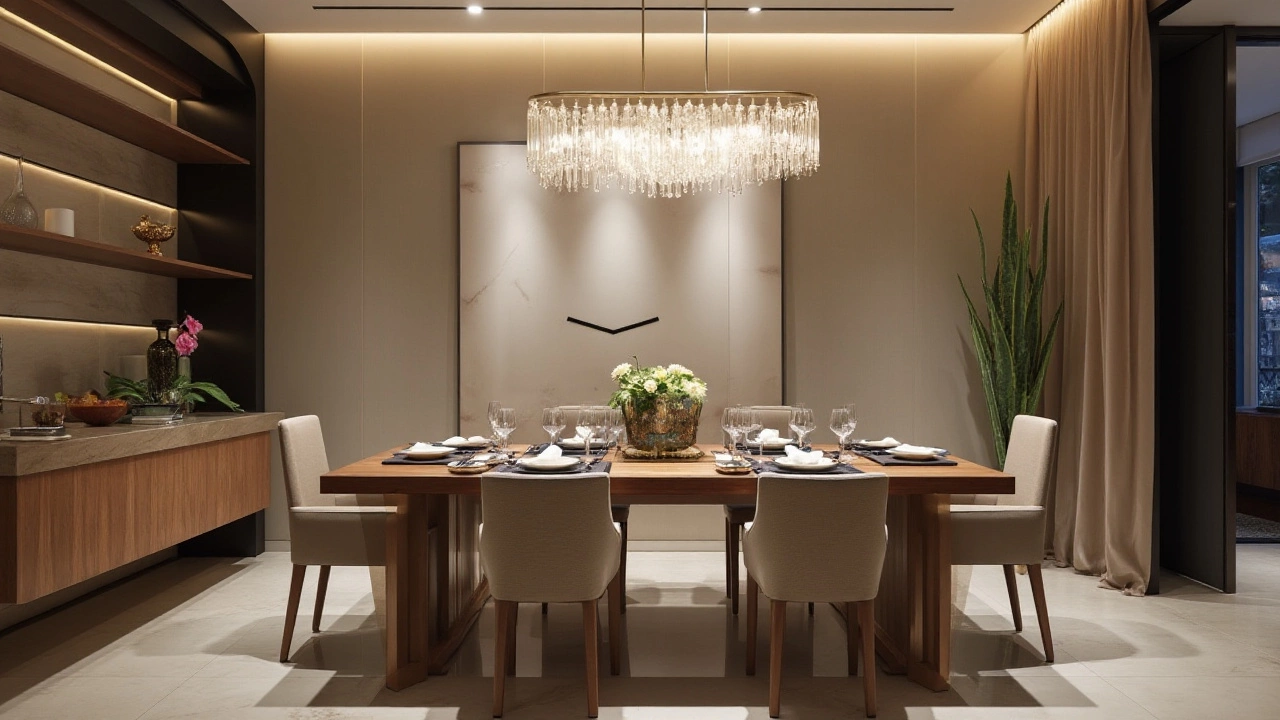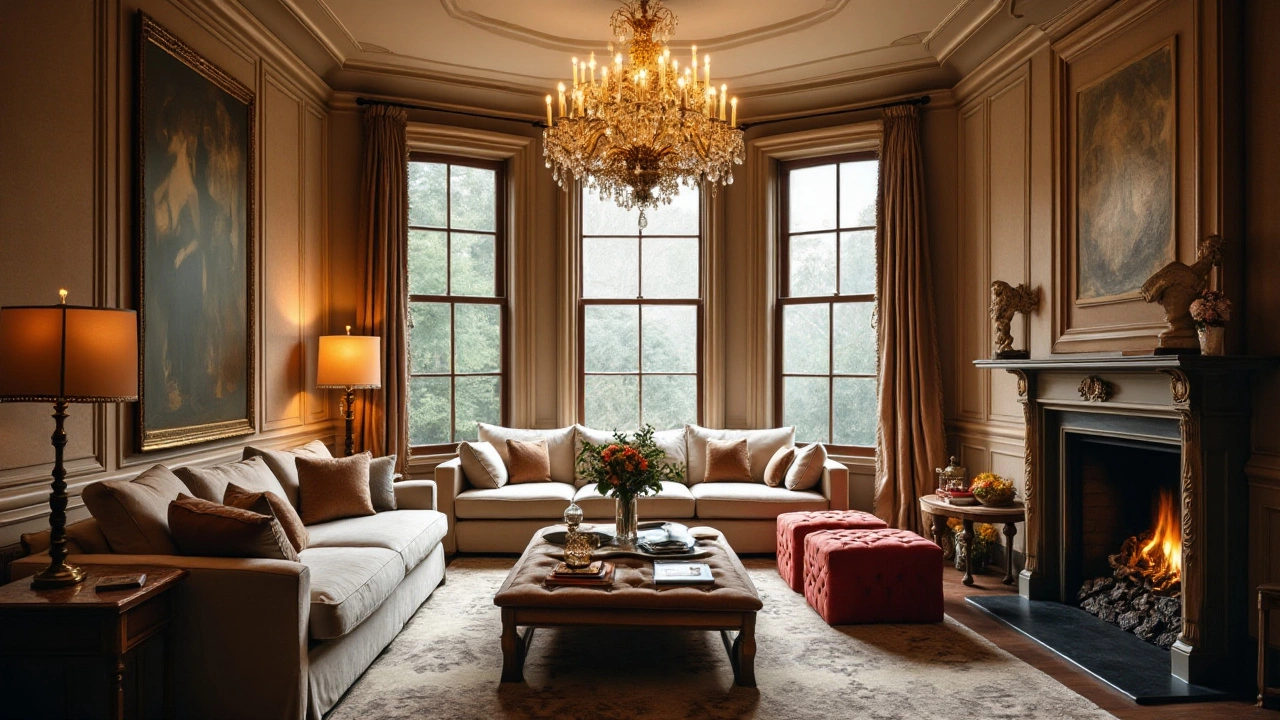Creating an exquisite ambiance in your home extends far beyond the color of your walls or the plushness of your carpets. In fact, one of the most powerful tools at your disposal is the type of lighting you choose. Whether you're aiming to emulate the sophistication of an opulent mansion or simply want to add a touch of refinement to your living spaces, lighting plays a pivotal role.
From the shimmer of a crystal chandelier to the subtle glow of concealed LED strips, each lighting element contributes uniquely to the decor. The goal isn't to fill every corner with light but to craft a soft, inviting play of light and shadow that speaks of elegance and comfort. As you consider your lighting options, remember that the right choices can transform your home from ordinary to extraordinary.
- Understanding Light Layers
- Statement Lighting Fixtures
- Ambient Lighting Techniques
- Accent and Task Lighting
- Color Temperature and Control
Understanding Light Layers
When designing a lighting scheme that makes a home look expensive and inviting, understanding the concept of light layers is crucial. Imagine a painting with different brushstrokes combining to create a masterpiece; lighting works similarly. It's not just about installing a singular, blinding source of light. Instead, it's about creating depth and dimension by blending various types of lighting. This approach to home lighting design is all about strategic placement and purpose, enhancing both functionality and aesthetics.
The first layer in any luxurious light setting is ambient lighting. This is the general lighting that illuminates spaces evenly, akin to the natural light from windows on a sunny day. Think of overhead fixtures, recessed lighting, and large chandeliers that provide the necessary brightness and warmth throughout a room. Ambient lighting is the foundation upon which other lighting layers are built, offering the first impression when you enter a room. It is designed to be subtle yet effective, filling spaces with a soft glow rather than harsh or obtrusive light.
Task lighting is the second layer, offering focused illumination for specific activities such as reading, cooking, or working at a desk. Unlike ambient lighting, task lighting needs to be bright and directed to reduce eye strain and increase productivity. Consider under-cabinet lights in the kitchen, desk lamps in a study, or vanity lights around mirrors. These are functional lights, yet when chosen with design in mind, they contribute to the expensive feel of a home. The key is to select fixtures that add character to the room while serving their purpose efficiently.
The third and most creative layer is accent lighting, which brings drama and flair to any home. Often overlooked, these lights highlight architectural features, artwork, or simply cast interesting shadows and patterns. Accent lighting adds depth and richness, subtly raising a room's elegance. Picture a small spotlight on a sculpture, wall-mounted lights flanking a dramatic art piece, or concealed lighting accentuating a textured wall. As renowned interior designer David Easton once remarked,
"Good lighting should enhance a room like makeup enhances a face."Emphasizing specific areas or objects can transform a space with a relatively low investment.
To achieve a harmonious blend across these layers, smart use of dimmer switches and smart lighting systems is recommended. They offer flexibility, allowing homeowners to adjust the intensity of light based on the time of day or the mood they wish to create. Imagine having a bright ambient light for a morning coffee and a dimmed, cozy glow for an intimate evening dinner. This level of control over home aesthetics helps craft an atmosphere that resonates luxury.
Statement Lighting Fixtures
Statement lighting fixtures are more than just a source of illumination; they're a powerful expression of style that can transform any room from drab to fab. Imagine entering a room where the lighting captures your eye before anything else—the kind of fixture that asks for attention in the most elegant of whispers. These standout pieces act both as functional items and pieces of art, telling a story of luxury and taste. Whether it's a sparkling chandelier in the foyer or an avant-garde pendant light over the dining table, statement lighting has an uncanny way of setting the tone for the entire home.
The beauty of statement lighting is in its variety and scale. Chandeliers, for example, have evolved dramatically from their grandiose, classical designs to more contemporary, eclectic styles. Modern interpretations might feature industrial materials or sleek, minimalist lines that offer a nod to tradition while enhancing modern aesthetics. An interesting statistic reveals that homes with intricate lighting setups featuring standout pieces can influence perceived property value by as much as 20%. People often choose fixtures that contrast with the décor or mesh subtly into the surroundings, infusing personality into the space without overwhelming it.
Another trend that has gained traction is the use of oversized pendant lights. These are perfect for creating a visual focus while adding a touch of drama to spaces like kitchens and living rooms. Oversized lights can be paired in multiples to create symmetry or used singularly for a standalone masterpiece. Interestingly, a study by the University of Sydney found that well-integrated lighting can improve mood and social interaction by complementing the spatial design. Besides offering visual appeal, the interaction between light and space enhances the overall mood, making your home not just beautiful but also welcoming.
"Lighting is not just functional. It's emotional." - Kelly Wearstler, Interior Designer
For those daring enough, sculptural lighting can make a big impact. These pieces blur the line between fixture and artwork, transforming the ceiling into a gallery. Think of intricate arrangements made with geometric shapes or organic forms that evolve with the space. The key to making bold lighting work in a home is scale and balance; the fixture should be proportionate to the room's size and other elements to ensure harmony. Pairing a bold light with neutral walls or minimalist furniture can make it the focal element you've been missing.
While exploring options, remember that materials also play a crucial role. Metals like brass and copper convey warmth and timelessness, while clear, frosted, or colored glass can provide a contemporary edge. Don't shy away from mixing materials either, as it can introduce layers of interest and texture to the ambiance. Always consider your existing color palette and textures when choosing a statement piece to ensure cohesiveness throughout your space.

Ambient Lighting Techniques
Creating a home that exudes opulence and luxury is as much about the atmosphere as it is about the decor. Ambient lighting, often considered the foundational layer of illumination, is essential in setting this tone. It provides a consistent, gentle light that fills the room, creating warmth and a welcoming vibe without overpowering the senses. The key to effective ambient lighting is to achieve the right balance of brightness – something that doesn’t clash with natural light during the day or become too harsh and glaring at night.
One of the most popular strategies to create ambient lighting in modern homes involves the use of recessed lights, often known as can or downlights. These discreet fixtures can be spread evenly across a ceiling to ensure an even distribution of light throughout the room. In spaces where maintaining a sleek and polished look is vital, such as living rooms and dining areas, recessed lighting provides a non-intrusive solution. Pairing these with dimmer switches expands their versatility, allowing homeowners to control the intensity of light to suit different activities or times of day, ranging from a bright glow for entertaining to a soft light perfect for intimate evenings.
Another effective technique involves the use of floor lamps and table lamps, particularly those with translucent shades that diffuse light gently throughout the area. These lighting options can enhance the overall home aesthetics by offering flexible, movable light sources while contributing artistically to a room's decor. When strategically placed in corners or next to seating areas, they add layers and depth to the room's lighting design.
Incorporating pendant lights can also add a touch of elegant lighting to your home's ambient arrangement. When installed at staggered heights, they create visual interest and enhance the room's vertical proportions, ideal for spaces with high ceilings. Pendant lights are perfect above dining tables or kitchen islands, where they make a statement while ensuring the areas are well-lit.
Architectural Digest once noted, "Good lighting is like a good outfit: it enhances but it doesn't overshadow you". This highlights the importance of ambient lighting being effective yet subtle.
Additionally, wall sconces positioned strategically around the home bring sophistication and a classic feel to any space. These fixtures are particularly advantageous in corridors or narrow spaces, offering a cozy glow without intrusive overhead lighting. The soft light cast by sconces can add a layer of tenderness that complements other elements in the room, contributing to an elegantly illuminated space.
For those seeking a more modern touch, LED strips offer a versatile means of introducing ambient lighting. These can be installed discreetly under furniture edges, behind TVs, or above cabinetry, casting a soft glow that accentuates the room’s features without being blinding. With the ability to change colors and intensities, LED technology allows for a dynamic lighting experience, adding to the luxury lighting effect without hefty energy bills.
Accent and Task Lighting
Accent and task lighting are the unsung heroes of home illumination, often going unnoticed but playing a crucial role in shaping the mood and functionality of living spaces. These lighting types are about more than just visibility; they bring attention to details, highlighting architecture, artwork, or the texture of a favorite piece of furniture. Accent lighting is typically used to focus on a specific object or feature within a room, like a piece of artwork or an architectural detail, and it's often achieved with spotlights or floodlights. Meanwhile, task lighting is more functional, designed to illuminate specific areas where activities such as reading, cooking, or working take place. Both forms of lighting help create layers within a room, adding depth and enhancing the ambiance.
When it comes to luxury home aesthetics, strategic use of accent lighting can transform a space from flat to breathtaking, adding a dramatic flair that speaks to the sophistication of the decor. Picture a grand living room where spotlighting casts a gentle beam on a stunning painting or a fine sculpture. This is not just about adding another source of light; it’s about crafting a scene that draws the eye and captivates the imagination. Similarly, task lighting under your kitchen cabinets or in your home office brings not only functionality but also a touch of modernity and precision to the room's aesthetics. For a polished look, opt for fixtures that reflect the home's style—sleek, modern LED desk lamps for a contemporary house, or classical brass sconces for a more traditional setup.
To ensure these lighting types work harmoniously with the rest of the room, it’s essential to consider their placement and beam intensity. Accent lights should not overpower their subjects but rather coax them into gentle prominence. Task lights, on the other hand, need to be bright enough to prevent eye strain while being adjustable to suit various needs and times of day. As noted by renowned architect Frank Lloyd Wright, "Form follows function—that has been misunderstood. Form and function should be one, joined in a spiritual union."
His philosophy underscores the importance of purposeful design, where every lighting decision is deliberate, marrying visual appeal and utility.
For those eager to introduce elegance into their home design, focusing on task lighting in areas like reading nooks or dressing rooms can enhance both luxury and convenience. Stylish task lights not only serve their basic purpose but can also act as decor statements themselves, choosing designs that complement other room elements such as fabric and color palettes. A vintage industrial lamp on a reading table or an ornate sconce in a hallway can serve dual purposes—providing necessary illumination and adding an element of surprise to home decor.
Finally, remember that lighting should evolve with the space's function and the homeowners' lifestyles. Adjustable fixtures, such as dimmable LEDs or smart lights operated via apps, allow for customization—a luxury itself. This ability to adapt light settings effortlessly can enhance everyday experiences and set the stage for special occasions. Thus, by skillfully integrating accent and task lighting, a home can truly become a tailored sanctuary, efficient by day and a haven of elegance by night.

Color Temperature and Control
When it comes to making your home look more expensive, understanding color temperature can be the secret weapon in your design arsenal. Color temperature, measured in Kelvin (K), influences the atmosphere of a room and can dramatically alter the feel of a space. Warm light, typically ranging from 2000K to 3000K, brings a cozy and inviting tone. It's the kind of light found in candles or traditional incandescent bulbs, perfect for living rooms and bedrooms where relaxation is key. On the other hand, cool light, which ranges upwards from 4000K to 6500K, mimics daylight and can make a space feel fresh, clean, and modern—ideal for kitchens and workspaces where clarity and concentration matter.
Incorporating a mix of both warm and cool lighting can add layers and depth to a home's aesthetics. By using dimmers and smart lighting systems, you can conveniently control the intensity and temperature of lights throughout the day. This flexibility allows you to shift the ambiance from bright and energizing in the morning to soothing and subtle in the evening without swapping fixtures or bulbs. Many modern lighting systems offer apps that enable users to pre-program different scenes or settings tailored to their daily routines or specific moods. Imagine transitioning from a bright, daylight-inspired office environment to a warm, cozy evening setting with just a tap on your smartphone.
Luxury Lighting and control systems have also advanced, offering features such as circadian rhythm automation, which adjusts lighting to mirror natural daylight patterns. This not only enhances the visual comfort but also promotes health and well-being. According to the National Sleep Foundation, exposure to natural light helps regulate human sleep cycles, leading to improved focus and mood. By leveraging technology, not only does your home look more elegant, but it also becomes a healthier place to live. Consider systems by companies like Philips Hue or Lutron, which are known for their reliability and ease of use.
"Lighting is everything. It creates atmosphere, drama, and intrigue in any home." - Martyn Lawrence Bullard, celebrated interior designer
For those who love hosting, color-changing LED lights can add a festive and lavish touch to gatherings or celebrations. Advanced LEDs can now produce a wide spectrum of colors, allowing you to tailor your environment for different occasions. However, the key to keeping an expensive look is to use color wisely. Stick to accents rather than overwhelming the space, ensuring your lighting choices remain stylish and understated.
When planning your lighting design, also pay attention to the direction and placement of light. Using lighting strategically can highlight architectural features, art pieces, or furniture, drawing eyes to the luxury elements of your home. Spotlights with adjustable color temperature and focus can serve this purpose well, creating a gallery-like effect in your living spaces. Regulate each room's glow, and without realizing it, you'll be crafting an inviting, deliberate ambiance that whispers 'luxury' to everyone who enters.
 EN
EN
 HR
HR
 AR
AR

